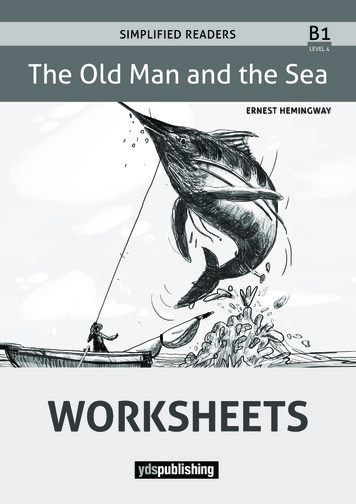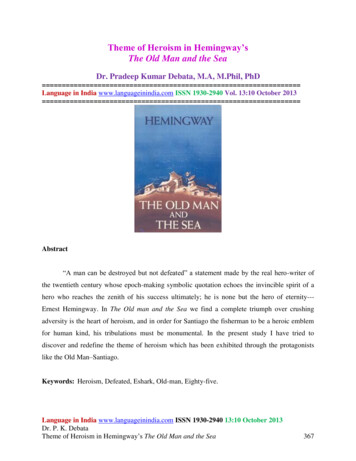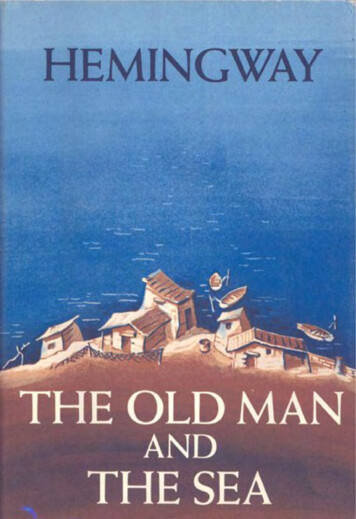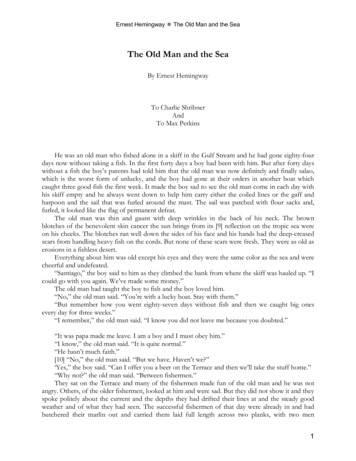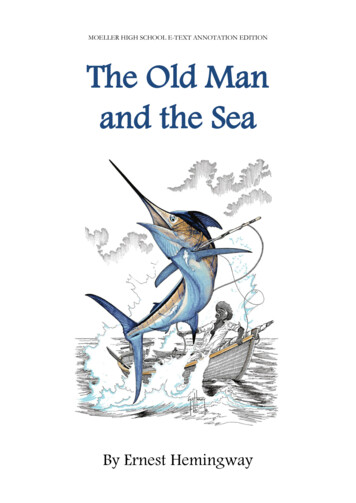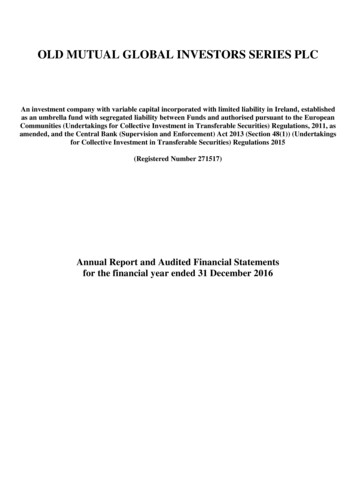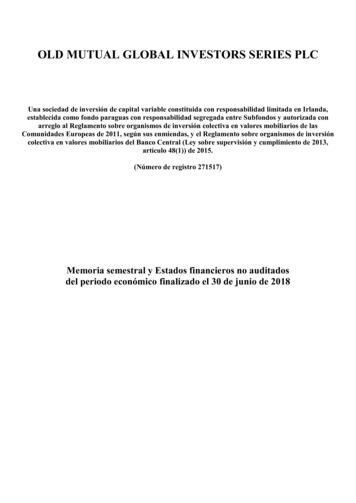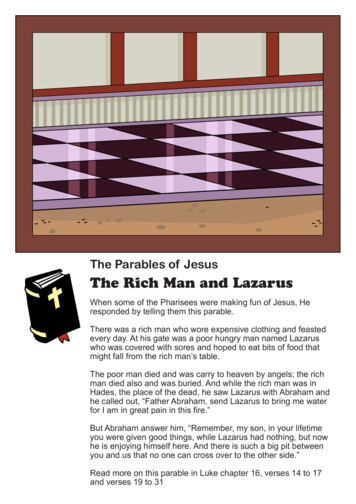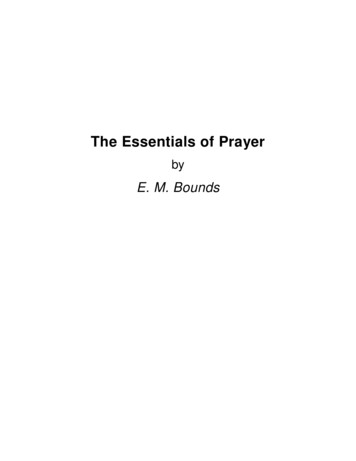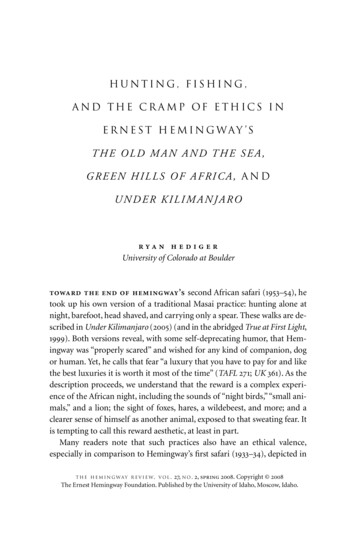
Transcription
Hunting, fishing,and the cra mp of ethics ine r n e s t h e m i n g way ’sTHE OLD MAN AND THE SEA,GREEN HILLS OF AFRICA, ANDUNDER KILIMANJAROrya n h e d i g e rUniversity of Colorado at Bouldertoward the end of hemingway’s second African safari (1953–54), hetook up his own version of a traditional Masai practice: hunting alone atnight, barefoot, head shaved, and carrying only a spear. These walks are described in Under Kilimanjaro (2005) (and in the abridged True at First Light,1999). Both versions reveal, with some self-deprecating humor, that Hemingway was “properly scared” and wished for any kind of companion, dogor human. Yet, he calls that fear “a luxury that you have to pay for and likethe best luxuries it is worth it most of the time” (TAFL 271; UK 361). As thedescription proceeds, we understand that the reward is a complex experience of the African night, including the sounds of “night birds,” “small animals,” and a lion; the sight of foxes, hares, a wildebeest, and more; and aclearer sense of himself as another animal, exposed to that sweating fear. Itis tempting to call this reward aesthetic, at least in part.Many readers note that such practices also have an ethical valence,especially in comparison to Hemingway’s first safari (1933–34), depicted inT H E H E M I N G W A Y R E V I E W , V O L . 27, N O . 2, spring 2008. Copyright 2008The Ernest Hemingway Foundation. Published by the University of Idaho, Moscow, Idaho.
36 T H EH E M I N G W A Yr E V I E WGreen Hills of Africa. Introducing Under Kilimanjaro, for instance, editorsRobert W. Lewis and Robert E. Fleming mention Hemingway’s changedattitude toward hunting, saying he “takes greater pleasure in merelywatching the wildlife” than in killing (xiv). In a recent article, “‘He OnlyLooked Sad the Same Way I Felt’: The Textual Confessions of Hemingway’s Hunters,” Carey Voeller also demonstrates that Hemingway showedmore and more sympathy toward animals on later trips, replacing his trophy-hunting mentality with a more complex view. For Voeller, thesechanges are part of a general shift in Hemingway’s later life. Voeller’s argument follows from Charlene Murphy’s work, which he cites, and resemblesa number of other studies that draw similar conclusions on this point.1Not mentioned in Voeller’s study but also relevant to this issue is GlenLove’s 1987 essay “Hemingway’s Indian Virtues.” Love condemns excessivekilling in Hemingway’s personal hunting practices (e.g. 203) and finds Hemingway’s Santiago in The Old Man and the Sea also too willing to kill thesharks and other animals of the sea that oppose his interests. However, Lovenotes signs of Hemingway’s shift toward greater ecological benevolence “atabout the time of the writing” of The Old Man and the Sea (209). As hereminds us, by this time Hemingway had published his belief that “it is a sinto kill any non-dangerous game animal except for meat” (qtd. in Love 209)and had spoken against other wanton killing. Love seems to deduce this as akind of moral code for Hemingway’s later hunting practices.Love’s analysis contrasts this growing sympathy with animals withHemingway’s status “as a modern and as an artist,” a maker “proclaimingof his own uniqueness, [which] also necessitated a destruction or diminishment of the natural world which he loved [. . .]” (205). For Love, artisticstyle conflicts with ethics. On this point, Love’s approach resembles critical arguments heard not long after release of The Old Man and the Sea.Although the novel was greeted with high praise at first, a second wave ofresponses was more skeptical. Philip Rahv, for example, calls the story“supple” and “exact” but also finds it limited because of Hemingway’s“chosen theme” (360). Rahv suggests that “its quality of emotion [is] genuine but so elemental in its totality as to exact nothing from us beyondinstant assent” (360). Philip Young praised the book highly in his first edition of Ernest Hemingway (1952), but in the 1966 edition notes his desire to“greatly tone down the praise for The Old Man and the Sea.” He proclaimsthat “although the tale is here and there exciting it is itself drawn out a lit-
r y a nh e d i g e r 37tle far. Even the title seems an affectation of simplicity, and the realizationthat Hemingway was now trading on and no longer inventing the stylethat made him famous came just too late” to Young, hence his initiallyhigh praise (274). Young heartily agrees with Dwight Macdonald, whowrote, “‘Nothing is at stake [in The Old Man and the Sea] except for theprofessional obligation to sound as much like Hemingway as possible’”(qtd. in Young 271–72). Indeed, Young uses this discussion to reflect hisbelief in “the declination of Hemingway’s powers—physical, mental,hence literary” (264). Such views all turn on the idea that the story’s themeis insignificant and that Hemingway’s use of his characteristic style is aform of “fakery,” to borrow Robert Weeks’s term. Style is at odds with serious, sincere writing in this critical framework.This notion of internal conflict recalls other, more recent criticalaccounts insofar as they understand Hemingway to embody, in Voeller’sconcluding words, “contradictory and very human ideas” (75). Murphyargues that Hemingway could both love and kill animals, recasting thisapparent contradiction as a “duality.” Similarly, as Lewis and Fleming markHemingway’s decreased interest in killing animals late in life, as mentionedabove, they suggest he took “pleasure” in watching animals instead. Thisword choice begs the question of what motivates this change (althoughclearly, unlike earlier critics, these readers find the theme of such worksvaluable). Has Hemingway merely substituted the pleasure of watching forthe pleasure of killing, without significantly considering the interests ofother forms of life? How are we to understand “pleasure” here? Or to framethe question more broadly, what relationship does aesthetic engagement,including experiential pleasure, have to ethics? Should we content ourselveswith the familiar but unsatisfying notion that Hemingway’s work and conduct regarding animals is complex because it is contradictory?This essay approaches this problem by revising what we mean by“ethics,” permitting us to find an important and principled consistency—one that develops more fully as time passes—in Hemingway’s conducttoward and writing about animals. While many critics of Hemingway’streatment of animals—Love, for example—suppose some clearcut ethicalprinciple against which that treatment can be measured, I rely on recenttheory presenting ethics as centered on openness to experience and to aesthetics. In this approach, ethical principles are subject to change based on
38 T H EH E M I N G W A Yr E V I E Wlocal conditions of time and place; ethical principles and human actors arethus more fully in dialogue. Hemingway’s rigorous attention to particularsand his lifelong stance against abstraction are therefore fundamental to hissense of ethics.After exploring these points about ethics with reference to the safaribooks Green Hills of Africa and Under Kilimanjaro, this essay will examineThe Old Man and the Sea to show its presentation of ethics as a rigorous,ongoing process. Santiago does not decide upon his ethical stance towardsthe marlin until he has undergone the encounter. But more crucially formy argument, the novel’s rigorous attention to style, to aesthetics, highlights the importance of something like deep inhabitation. The style ofThe Old Man and the Sea conveys Santiago’s keen, embodied awareness ofthe Cuban marine environment and its life, and that awareness is not onlyvaluable in itself, but fundamentally informs his ethical considerations.Crucially, this form of ethics is not some rote application of a rule aboutnever killing animals. Hemingway is fully aware of the fact that eatingrequires killing. Rather, this paper argues that in Hemingway’s later texts,dead animals—the number of trophies, the size of their horns, or theweight of their flesh—become less necessary as a measure or memento ofhis hunting or fishing experience, and ethical experience itself takesgreater emphasis.sport and ethicsThe safari presented in Green Hills of Africa can seem merely a masculinecontest in killing power, measured in simple terms such as the sheer numbers of animals killed or the size of their horns. The book’s ethics wouldtherefore involve not shooting animals from moving vehicles, obeyinglicense requirements, and doing one’s best to be civilized in the midst ofthe struggle to best one’s hunting companions. The primary plot line ofGreen Hills of Africa consists of a competition between Karl and the Hemingway-figure narrator for size and quality of trophies, while the book’ssubplot is a literary competition between forms of writing. Hemingwayannounces this literary competition in the Foreword: “The writer hasattempted to write an absolutely true book to see whether the shape of acountry and the pattern of a month’s action can, if truly presented, com-
r y a nh e d i g e r 39pete with a work of the imagination” (my emphasis). In the literary asidesthat recur through the book, Hemingway develops this element into a justification for the nonfiction form he is practicing.But winning such competitions is not the book’s highest value. Hemingway, although he presents himself as more skilled than Karl, loses thebattle of the trophies consistently and finally (e.g. GHOA 63, 83, 86, 153,291, and passim). He also admits to himself and to readers that M’Cola,one of the African hunters, “was immeasurably the better man and thebetter tracker” (269). The literary competition also proves difficult toresolve as victory or defeat; the distinction between a work of the imagination and an “absolutely true book” erodes when Hemingway expresses hisaspiration not only as wanting “to try to write something about the country and the animals and what it’s like to someone who knows nothingabout it,” but also to evoke how he and his companions “feel about thecountry,” to indicate “the way we feel about it” (194). This kind of talkabout “feel” pushes the nonfiction form back toward fiction or narrative,and without an absolute distinction between forms, how can we say oneform has bested the other?In all of these cases throughout Green Hills of Africa, the framework ofcompetition modulates into something more complex, focused always onexperiences of the country and their value. Acknowledging this point permits us to revisit Hemingway’s conflict with himself about the animals heshoots and his desire to beat Karl. For instance, near the end of the bookwhen he is pursuing sable, Hemingway explains, “I did not mind killinganything, any animal, if I killed it cleanly,” because he “ate the meat andkept the hides and horns” (GHOA 272) and therefore did not waste theanimal’s life. But, Hemingway continues, he “felt rotten sick over this sablebull” because “I wanted him damned badly, I wanted him more than Iwould admit” (272). Read strictly in terms of the plot about competition,Hemingway feels sick about the intensity of his desire because it isungentlemanly.But this internal conflict must also be read in terms of what the animalssignify outside of human-to-human competition. Again and again, members of the safari note the beauty of the animals they kill. Poor OldMomma, to cite one example, says of a rhino Hemingway shoots, “Didn’the look wonderful going along there?” (GHOA 77). Cognizance of the paradox of killing to preserve should be read back into Hemingway’s reluc-
40 T H EH E M I N G W A Yr E V I E Wtance to admit how much he wants, for example, to find and kill the sable.The nature of this paradox becomes clearer by the end of the book, whenHemingway expresses his wish to return to Africa with more time to “getto know it as I knew the country around the lake where we were broughtup” (GHOA 282). On this return trip he would “see the buffalo feedingwhere they lived, and when elephants came through the hills we would seethem and watch them breaking branches and not have to shoot [. . .].” Hewould be able to “see them long enough so they belonged to me forever,”without always having to kill them (GHOA 282). The animal trophies areonly imperfect mementos, standing against the flight of time and thenecessity of leaving the place; they are imperfect replacements, like narratives or other such texts, for experience itself, which is the real value.When Hemingway falters on the thin satisfaction of the trophy as asupplement for ongoing experience, what arises is an interrogation of thelarger life conditions that make trophies seem desirable in the first place.That is why his critique of the trophy mentality, already developing inGreen Hills of Africa, amounts not to some simple rule about killing animals, but to a whole system of regard for place, inhabitation, and animals.At stake is the way he lives in the world. Suzanne del Gizzo, working withTrue at First Light before the release of Under Kilimanjaro, makes a similarpoint about Hemingway’s second safari. She suggests that this text showshow, in Africa, he “may have been seeking to become a member of a culture without writers—a place where he would have the opportunity toexplore himself and re-define his identity on other terms” (518). In otherwords, Hemingway wanted to inhabit the place seriously more than hewanted to produce artifacts (like texts, or trophies) about brief visits.This anti-product orientation is already visible in Green Hills of Africa,visible even in the often-discussed rebuke of the “foreigner,” who“destroys, cuts down the trees, drains the water [. . .]” and so on (GHOA284). This famous critique opens with the observation that “A continentages quickly once we come,” its first person plural (“we come”) self-consciously positioning Hemingway squarely and self-consciously within thecolonialist behavior he challenges and justifying his unease about participating in the trophy-hunting safari (284). Within this critique of colonialism are further signs of this book’s often conflicted discourse. Immediatelyfollowing this searing comment is Hemingway’s insistence that he “wouldcome back to Africa” and that “we always had the right to go somewhere
r y a nh e d i g e r 41else” (285, my emphasis). Such points are more than contradictory. Theyforeground the fact that we always inherit subject positions that are, tosome extent, beyond our control, that we are often complicit in realitieswe did not choose, and that we must work to recognize who and what weare if we are to make ethical choices. The narrative in Green Hills of Africapresents Hemingway at least partly coming to terms with the system heinhabits, experiencing an uneasiness, a kind of cramp of ethical feeling.In the second safari, Hemingway extends and solidifies many of the lessons he learned on the first safari, constantly underscoring the value ofdeep inhabitation. In a key passage, he does so explicitly, and as is oftenthe case in his work, he writes about his awareness of place in terms of theanimals who live there:I thought how lucky we were this time in Africa to be living long enough in one place so that we knew the individual animals and knew the snake holes and the snakesthat lived in them. When I had first been to Africa wewere always in a hurry to move from one place to another to hunt beasts for trophies. If you saw a cobra it was anaccident as it would be to find a rattler on the road inWyoming. Now we knew many places where cobraslived. (UK 116; TAFL 97–98)This more local and particular awareness seems tied to the claim he makesin the next paragraph: ”The time of shooting beasts for trophies was longpast with me.” Instead, he “was shooting for the meat we needed to eat andto back up Miss Mary and against beasts that had been outlawed for cause[. . .]” (TAFL 98; UK 117). Although the paragraph goes on to mention animpala that he did in fact shoot “for trophy,” Hemingway clearly marksout a critique of wasteful killing here, as critics have suggested. In place ofthe recreational pursuit of animals that is trophy hunting, Hemingwayemphasizes his engaged knowledge of place and his experiences. Theseexperiences, like the strange pleasures of walking at night, are more aesthetic and qualitative than the more easily calculated, quantitative successes in killing.These two systems of evaluating safari trips provide useful examples forthinking about ethics more generally. In the trophy-hunting system, ethics
42 T H EH E M I N G W A Yr E V I E Ware essentially rules that permit the game of competition among humans toproceed. There are rules about how to kill animals and about how manyanimals can be killed, and more subtle expectations about decency towardone’s fellow competitors. The rules are more or less fixed, and the hunterssimply follow them. The system ostensibly values animals insofar as theycannot be heedlessly slaughtered, but not much beyond that, and views theenvironment as a backdrop for a human endeavor. Hemingway inhabitedthis approach to animals and to hunting uneasily even on his first safari. Onthe second safari, advances in his thinking about inhabiting place register ina relatively minor shift regarding the ethics of killing animals—he will do soonly for meat. But this specific principle is only the tip of his ethical iceberg.The less visible portions of this structure involve a thorough awareness ofwhat it means to be one among many mortal animals in a larger ecology,one consequence of his deep inhabitation. Indeed, it is partly the mortalitywe share with animals that renders our encounters with them meaningful.Although there is not space to explore this notion fully here, our everpresent need to eat is a sign of our corporeality and mortality, a sign ofhuman limitation that heightens Hemingway’s desire to attend to experience carefully. He constantly feels time passing. With such cognizance,Hemingway treats animals neither as pawns in a human competition, noras beings so entirely foreign that he believes himself outside of the naturaleconomy in which life depends upon other forms of life. Thus, he continues to hunt and kill animals for food.This account of ethics, which distinguishes following a rule from havinga sensibility open to experience, may sound somewhat strained given thatHemingway can simply be understood to follow a rule—only kill animalsfor meat. But such a view of ethics mistakes the role of the ethical agent,who, for Hemingway and for theorists like Jacques Derrida, must takegreater responsibility for being ethical than simply following rules. Moreover, this paper’s approach to ethics permits people in a different contextthan Hemingway’s to reach different conclusions about hunting. For example, knowing how overfished today’s oceans are, an individual might decideto avoid killing fish even to eat them, at least until populations recover.This second system of ethical regard refuses to separate the agent fromthe ethical system, so that Hemingway must constantly revisit the principles with which he confronts animals and places.The first system, one in which a set of ideas or rules is generally stable, is
r y a nh e d i g e r 43a more familiar notion of ethics to many of us. The agent’s task is simply toobey (or disobey) that system. Hemingway was famously suspicious of suchabstract systems of understanding.2 His work on this point resembles latercritiques of ethical systems in law, religion, and other fundamental doctrines. Geoffrey Galt Harpham explains that such critiques, which gatheredforce in the 1960s, understood conventional ethical systems as merely “rendering mystical and grand their [creators’] own private interests or desires”(387). For instance, in the case of trophy hunting, the animal head or carcasswould function as a sign of human prowess and mastery over nature in general. On safaris, trophies would reiterate the international hegemonic system, as the white European demonstrated his (or, less often, her) masteryover the nature of Africa, including both humans and animals. Implicit inthis colonialist and imperialist view was, now quite infamously, a set of “ethical” implications, perhaps most egregiously expressed in the idea of the“white man’s burden” to “civilize” non-Europeans.Critiques of such misguided ethics have led to revised notions of whatethics might mean more generally, revisions often referred to as the “ethicalturn” in contemporary examples. Philosophers like Emmanuel Levinas andlater Jacques Derrida, who was influenced by Levinas, worked to revive orreform ethical discourses by shifting notions of ethics away from merelyobeying pre-established codes. In their analyses, ethics must factor the complexities of experience into inherited codes and understandings. The defamiliarizing, often profoundly upsetting character of experience is discussedin Levinas’s work, especially Otherwise Than Being, as exposure to the radical difference between self and other. Levinas’s conception of these mattersembodies the experience of ethics in the very viscera at times. Near the conclusion of Otherwise Than Being, for example, he writes that “the subjectgives himself and exposes himself in his lungs, without intentions and aims,[. . .] the subject could be a lung at the bottom of its substance” (180). Insuch accounts, we are exposed to the other in all of our dealings. The involuntary character of breathing thus serves as a figure for and example of ethical selfhood that we enter into without ever having decided to do so. We areimmersed in a world that continually makes ethical demands upon us. ForLevinas, only in such a conception can we practice the doubting of self andlaw that sincere ethical practice requires, sometimes going so far as to do theopposite of what cultural codes such as laws would command. Derrida hasrecently summarized this approach to ethics by saying that “casting doubton responsibility, on decision, on one’s own being-ethical” is at the center
44 T H EH E M I N G W A Yr E V I E Wof ethics (128).3Hemingway undertakes this type of endeavor in his barefoot night walksin Africa, becoming “properly scared” in order to experience the complexitiesof the place under Kilimanjaro. This embodied exposure to the radical otherness of night and of dangerous animals such as cobras and lions enriches hissensibility and his writing. Night walking therefore connects to a profoundlyhumbled sense of self at the level of the body. Hemingway deliberatelyimmerses himself in a large and potentially dangerous world that dwarfs themeaning of the individual and presents new insights about how such a lifemight be lived. This ethical sensibility renders Under Kilimanjaro a book thatLewis and Fleming call “most lighthearted yet unconventionally serious” (UKviii), an apt description for much of Hemingway’s work. The book reiteratesthe often intimate connection between art and life for Hemingway; writingwas a way for him to draw new conclusions about how to live, or about ethicsin general terms. As with Green Hills of Africa, the (mostly) nonfiction genreof Under Kilimanjaro marks Hemingway’s seriousness in considering Africa,as the book works with actual events. But in Under Kilimanjaro, theencounter between Hemingway and Africa requires a new openness andreceptivity on Hemingway’s part, a kind of negative capability that is distinctly ethical in the sense described by Derrida and Levinas.Yet Hemingway’s idiosyncratic adoption of Masai practices can also beseen as a suspicious form of “going native,” one for which he has beensharply criticized, especially in ethical terms. Toni Morrison, for instance,understands Hemingway’s primitivism in books like The Garden of Edento depend on a notion of Africa as a “blank, empty space into which heasserts himself ” (88–89). I believe Morrison is at least partly right, asHemingway himself was aware, and as I have argued, in the case of GreenHills of Africa. But I am also suggesting that to a significant extent, theopposite is true; Hemingway regarded himself as a partly blank page ontowhich Africa and African cultures could write themselves. In saying so, Ido not mean to excuse each of Hemingway’s actions so much as to indicate how his notion of ethics allows for cross-cultural and evenhuman/nonhuman exchanges. Throughout his life, defamiliarization inforeign cultures and places seems to have helped him consider the rationales for ethical systems and work to formulate an ethical system of hisown that was more than the mere abstractions he so disliked. Some of thenuances of his ethical sensibility appear in the carefully crafted presenta-
r y a nh e d i g e rtion of Santiago, that “strange old man” (OMATS 66). 45t h e c r a m p o f e t h i c s i n the old man and the s eaThe Old Man and the Sea is a critique of triumphalist hunting. It unravelsSantiago’s apparently great victory at sea, delivering a mere skeleton for atrophy. Indeed, the marlin’s skeleton signifies the impossibility of a trophysufficient to represent either the living fish or Santiago’s experience of thehunt and his knowledge of the sea. The skeleton trophy also suggests theerror implicit in commodifying the sea and attempting to turn its life intoproduct. Santiago, thoroughly knowledgeable about the local environment, understands and admits his error, and is ultimately forced to revisehis ethical code: “‘I shouldn’t have gone out so far, fish,’ he said. ‘Neitherfor you nor for me. I’m sorry, fish’” (OMATS 110). By story’s end, Santiago’s own survival is in doubt as he is revealed to be on the edge of death.Deliberately putting his person into a position of doubt, defamiliarizinghimself in an environment he generally knows well, is a premise of Santiago’s trip and of his fishing practice more broadly. As Susan Beegel hasrecently shown in “A Guide to the Marine Life in Ernest Hemingway’s TheOld Man and the Sea,” Santiago is well-attuned to the otherness of the oceanand its animals. With rigorous detail, Beegel maps the ways in which Hemingway has, in minimalist fashion, rendered Santiago’s knowledge of the sea.Beegel summarizes her findings by saying, “A few strokes of his [Hemingway’s] pen sufficed to limn a lifetime of intimacy with the sea and its creatures [. . .].” (309). On the trip depicted in the book, Santiago has gone further out to sea than is common. The distance and his primitive gear exposehim quite fully to the whims of the ocean, to his prey, and to the sharks.Beegel’s essay clarifies the gravity of this danger, for example, in Santiago’sencounter with the mako shark, which “could easily result in the destructionof Santiago’s skiff and his death from injury or drowning” (265). In thisrespect, his trip resembles Hemingway’s late-night walks in Africa. BothSantiago and Hemingway limit their abilities to exert agency, trading controlfor raw, direct, informative experience, registered on their bodies.Hemingway’s presentation of Santiago emphasizes the shock of difference with rigorously crafted writing in which elements of style evoke whatcannot be properly described in direct language: Hemingway’s iceberg principle. We might call this style “skeletal” in the context of The Old Man andthe Sea. Such writing, using understatement, repetition, and the like, oftenconveys embodied experiences, so that a stylistically complex description
46 T H EH E M I N G W A Yr E V I E Wtestifies to the dissonance between actual, full-bodied experience and thecraft or technology of representing it with language. This stylisticapproach, exemplified below, often amounts to a claim of humility and isfrequently described as a kind of ethic (e.g. Bickford Sylvester “Hemingway’s Extended Vision”). But more than this, such style aligns with whatZoe Trodd has recently called a “politics of form” that reaches beyondwhat can easily be shown, acknowledging the difficulties of representation(Trodd 8). In Hemingway’s carefully constructed contexts, the word, thetrophy, and other such signs carry marks of their insufficiency to reproduce complex reality.4The limitations of representation appear as part of a more generalapproach to subjectivity in The Old Man and the Sea, in which even inhabitation of the body is a sign of limited agency. The signature moment ofweakness, doubt, and ethical consideration for the present discussionoccurs as Santiago begins to tire in his fishing travail, his left hand cramping closed:He rubbed the cramped hand against his trousers andtried to gentle the fingers. But it would not open. Maybeit will open with the sun, he thought. Maybe it will openwhen the strong tuna is digested. If I have to have it, Iwill open it, cost whatever it costs. But I do not want toopen it now by force. Let it open by itself and come backof its own accord. After all I abused it much in the nightwhen it was necessary to free and untie the various lines.(OMATS 60)Santiago is neither completely at home in his body nor able to inhabitsome disembodied self. His ethical position with regard to his left hand—”let it open by itself ”—is driven by the implicit understanding that thehand will function best when its needs are acknowledged, whatever thedesires of the organizing subject who would have it do as he pleases. Handis to body here as self is to environment more generally in the story.Hemingway’s style reveals dissonance between systems of understanding, such as language or ethics, and local realities of place, including theindividuals who live in those places and the systems they use. The appearance of Spanish phrases in The Old Man and the Sea, for example, recalls
r y a nh e d i g e r 47the particular, local conditions of his Cuban setting, marking the difference between actuality and Hemingway’s textuality, meant to address abroader audience. Early on, for instance, we read that Manolin asks Santiago to “‘Tell me about the great John J. McGraw.
wrote, "'Nothing is at stake [in The Old Man and the Sea] except for the professional obligation to sound as much like Hemingway as possible'" (qtd. in Young 271-72). Indeed, Young uses this discussion to reflect his belief in "the declination of Hemingway's powers—physical, mental, hence literary" (264).


